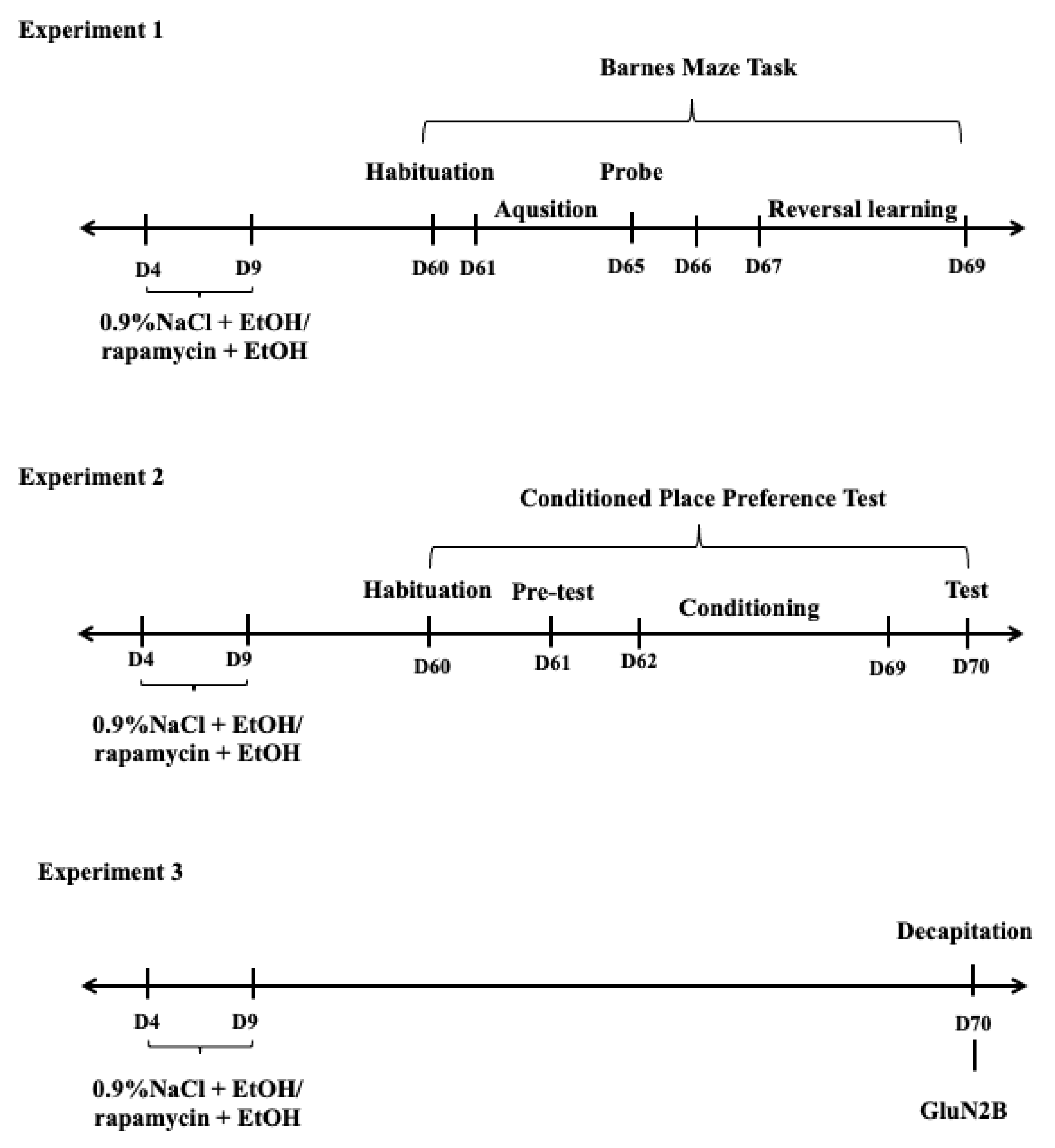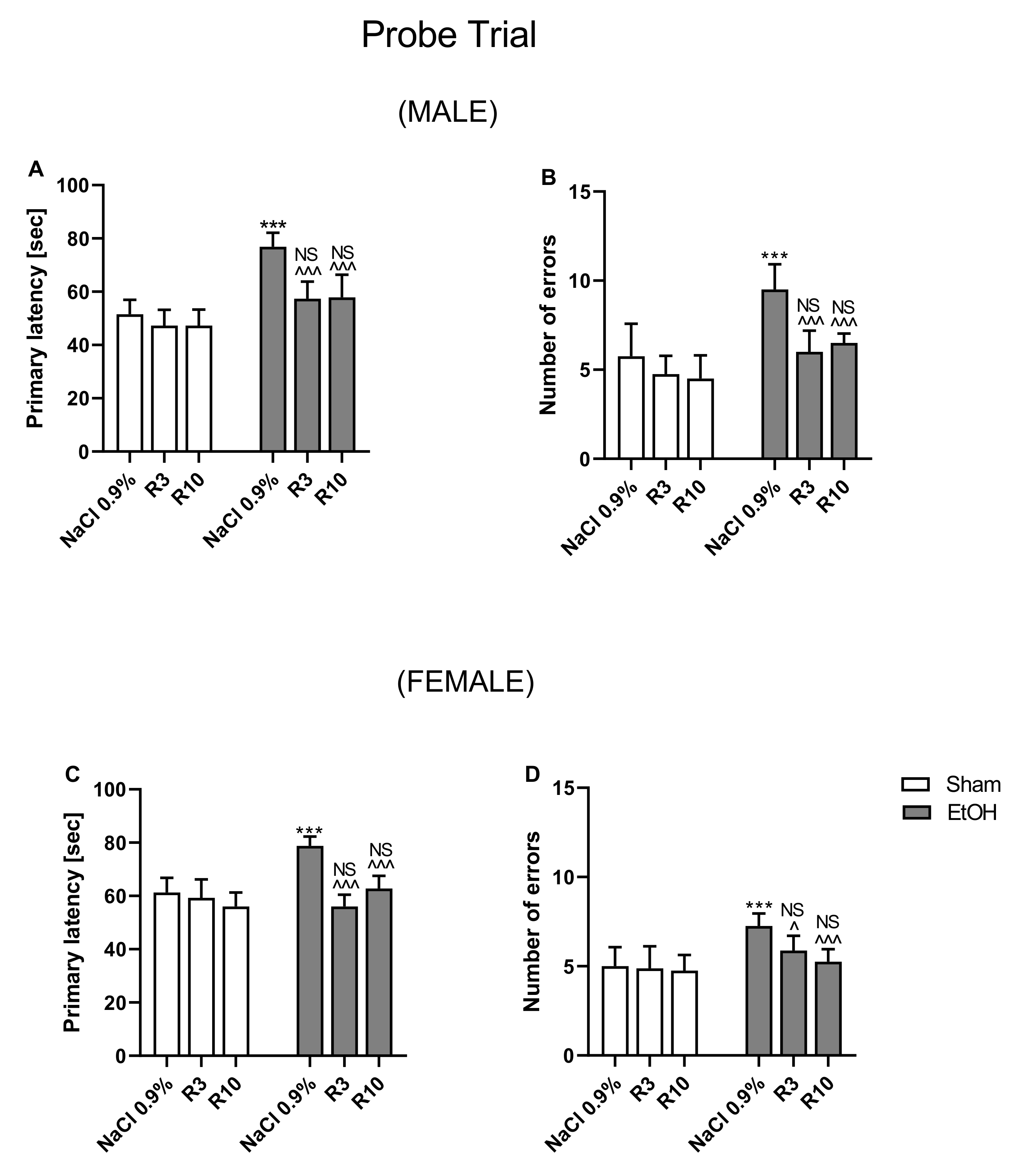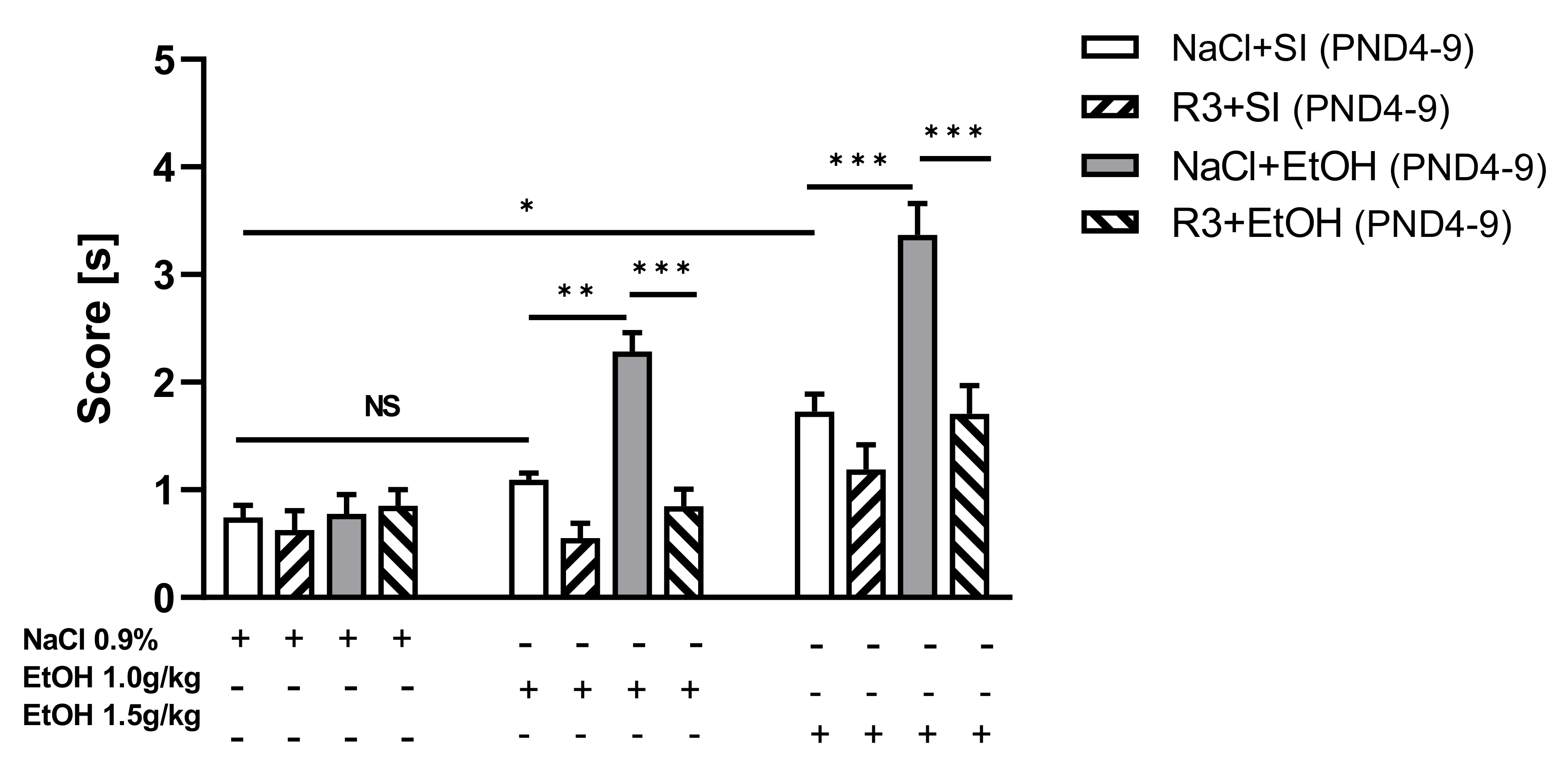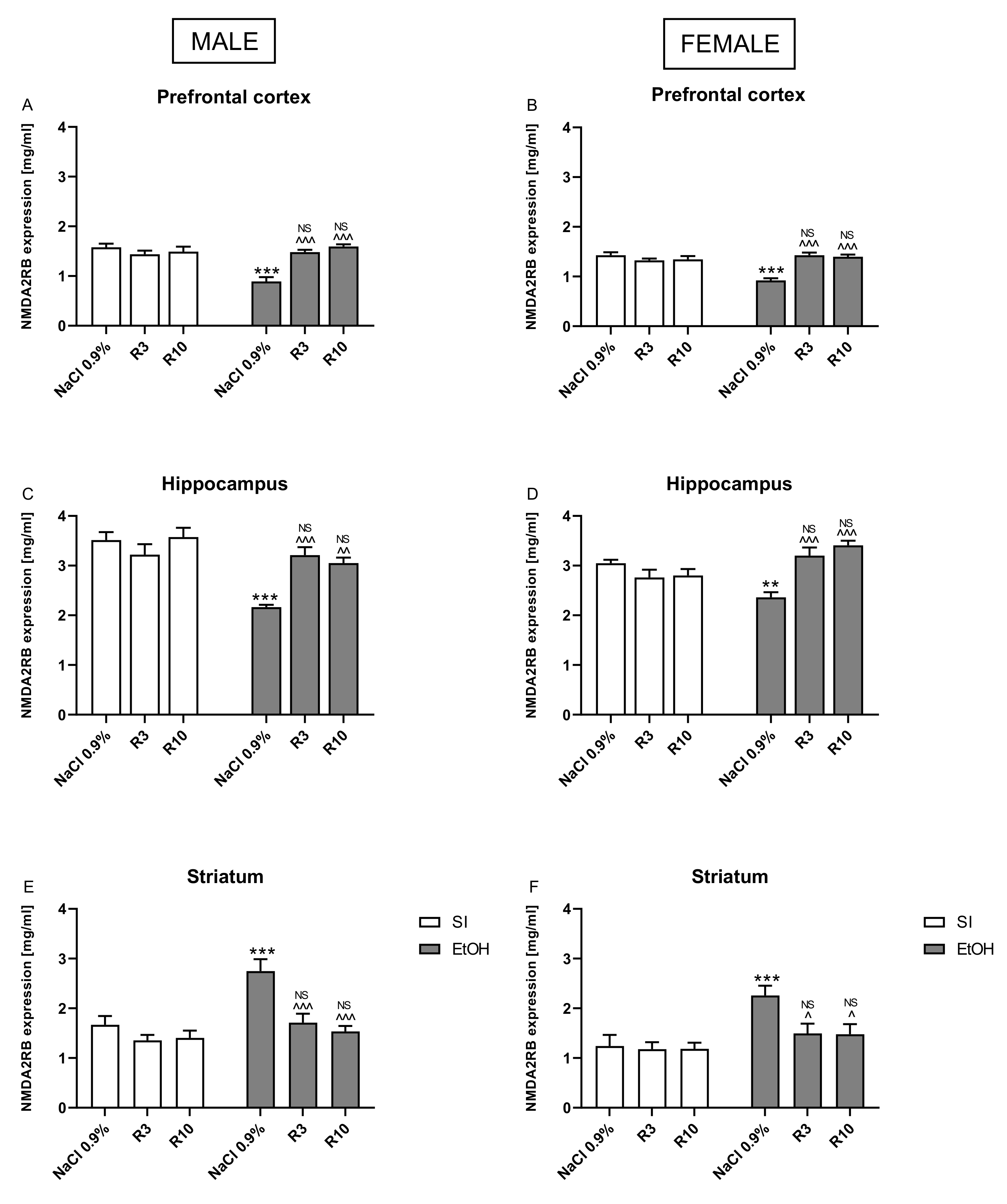Rapamycin Improves Spatial Learning Deficits, Vulnerability to Alcohol Addiction and Altered Expression of the GluN2B Subunit of the NMDA Receptor in Adult Rats Exposed to Ethanol during the Neonatal Period
Abstract
1. Introduction
2. Materials and Methods
2.1. Animals
2.2. Neonatal Ethanol Exposure and Rapamycin Administration
2.3. Barnes Maze Task
2.3.1. Habituation Phase
2.3.2. Acquisition Phase
2.3.3. Probe Trial
2.3.4. Reversal Learning
2.4. Preparation of Synaptosomal Membranes from NR2B Subunits of NMDA Receptor Expression
SDS-PAGE Electrophoresis and Western Blot Analysis
2.5. Conditioned Place Preference (CPP)
CPP Procedure
2.6. Statistical Analyses
3. Results
3.1. The Influence of Rapamycin Pre-Treatment before Every Ethanol Administration during PND4-9 on the Acquisition Memory of the Barnes-Maze Task in Adult (PND61–65) Male and Female Rats
3.2. The Influence of Rapamycin Pre-Treatment before Every Ethanol Administration during PND4–9 on the Spatial Memory in the Barnes-Maze Task in Adult (PND65) Male and Female Rats
3.3. The Influence of Rapamycin Pre-Treatment before Every Ethanol Administration during PND4-9 on the Reversal Learning in the Barnes-Maze Task in Adult (PND 66–69) Male and Female Rats
3.4. The Effects of Rapamycin Pre-Treatment before Every Ethanol Administration during PND4–9 on the Rewarding Effects of Ethanol in Adult Male Rats (70PND) in CPP Test
3.5. The Effects of Rapamycin Pre-Treatment on the Expression of the Synaptosomal GluN2B Levels in the Hippocampus and Prefrontal Cortex in Adult Male and Female Rats Exposed to the Ethanol during Neonatal Period
4. Discussion
4.1. Rapamycin Prevents Ethanol-Induced Spatial Memory Impairment and Reversal Learning
4.2. Rapamycin Prevents Rewarding Effect of Ethanol
4.3. Rapamycin Prevents Ethanol Induced Changes in GluN2B Subunit Expression
4.4. Potential Mechanism of Rapamycin
5. Conclusions
Author Contributions
Funding
Institutional Review Board Statement
Data Availability Statement
Conflicts of Interest
References
- Dörrie, N.; Föcker, M.; Freunscht, I.; Hebebrand, J. Fetal alcohol spectrum disorders. Eur. Child Adolesc. Psychiatry 2014, 23, 863–875. [Google Scholar] [CrossRef]
- Senturias, Y.; Asamoah, A. Fetal alcohol spectrum disorders: Guidance for recognition, diagnosis, differential diagnosis and referral. Curr. Probl. Pediatr. Adolesc. Health Care 2014, 44, 88–95. [Google Scholar] [CrossRef] [PubMed]
- Jones, K.L.; Smith, D.W. Recognition of the fetal alcohol syndrome in early infancy. Lancet 1973, 3, 999–1001. [Google Scholar] [CrossRef]
- Willoughby, K.A.; Sheard, E.D.; Nash, K.; Rovet, J. Effects of prenatal alcohol exposure on hippocampal volume, verbal learning, and verbal and spatial recall in late childhood. J. Int. Neuropsychol. Soc. 2008, 14, 1022–1033. [Google Scholar] [CrossRef] [PubMed]
- Manji, S.; Pei, J.; Loomes, C.; Rasmussen, C. A review of the verbal and visual memory impairments in children with foetal alcohol spectrum disorders. Dev. Neurorehabilit. 2009, 12, 239–247. [Google Scholar] [CrossRef]
- Beninger, R.J.; Gerdjikov, T. The role of signaling molecules in reward-related incentive learning. Neurotox. Res. 2004, 6, 91–104. [Google Scholar] [CrossRef]
- Zhai, H.F.; Zhang, Z.Y.; Zhao, M.; Qiu, Y.; Ghitza, U.E.; Lu, L. Conditioned drug reward enhances subsequent spatial learning and memory in rats. Psychopharmacology 2007, 195, 193–201. [Google Scholar] [CrossRef]
- Gould, T.J. Addiction and cognition. Addict. Sci. Clin. Pract. 2010, 5, 4–14. [Google Scholar] [PubMed]
- Goodman, J.; Packard, M.G. Memory Systems and the Addicted Brain. Front. Psychiatry 2016, 25, 7–24. [Google Scholar] [CrossRef]
- Brancato, A.; Castelli, V.; Cavallaro, A.; Lavanco, G.; Plescia, F.; Cannizzaro, C. Pre-conceptional and Peri-Gestational Maternal Binge Alcohol Drinking Produces Inheritance of Mood Disturbances and Alcohol Vulnerability in the Adolescent Offspring. Front. Psychiatry 2018, 23, 150. [Google Scholar] [CrossRef]
- Spear, N.E.; Molina, J.C. Fetal or infantile exposure to ethanol promotes ethanol ingestion in adolescence and adulthood: A theoretical review. Alcohol. Clin. Exp. Res. 2005, 29, 909–929. [Google Scholar] [CrossRef] [PubMed]
- Barbier, E.; Pierrefiche, O.; Vaudry, D.; Vaudry, H.; Daoust, M.; Naassila, M. Long-term alterations in vulnerability to addiction to drugs of abuse and in brain gene expression after early life ethanol exposure. Neuropharmacology 2008, 55, 1199–1211. [Google Scholar] [CrossRef] [PubMed]
- Cantacorps, L.; González-Pardo, H.; Arias, J.L.; Valverde, O.; Conejo, N.M. Altered brain functional connectivity and behaviour in a mouse model of maternal alcohol binge-drinking. Prog. Neuropsychopharmacol. Biol. Psychiatry 2018, 8, 237–249. [Google Scholar] [CrossRef] [PubMed]
- Parker, M.O.; Evans, A.M.; Brock, A.J.; Combe, F.J.; The, M.T.; Brennan, C.H. Moderate alcohol exposure during early brain development increases stimulus-response habits in adulthood. Addict. Biol. 2016, 21, 49–60. [Google Scholar] [CrossRef]
- Marmiroli, P.; Cavaletti, G. The glutamatergic neurotransmission in the central nervous system. Curr. Med. Chem. 2012, 19, 1269–1276. [Google Scholar] [CrossRef]
- Mayford, M.; Siegelbaum, S.A.; Kandel, E.R. Synapses and memory storage. Cold Spring Harb. Perspect. Biol. 2012, 4, 5751. [Google Scholar] [CrossRef]
- Lüscher, C. Drug-evoked synaptic plasticity causing addictive behavior. J. Neurosci. 2013, 33, 17641–17646. [Google Scholar] [CrossRef]
- Pierrefiche, O. Long Term Depression in Rat Hippocampus and the Effect of Ethanol during Fetal Life. Brain Sci. 2017, 7, 157. [Google Scholar] [CrossRef]
- Zhang, T.A.; Hendricson, A.W.; Wilkemeyer, M.F.; Lippmann, M.J.; Charness, M.E.; Morrisett, R.A. Synergistic effects of the peptide fragment D-NAPVSIPQ on ethanol inhibition of synaptic plasticity and NMDA receptors in rat hippocampus. Neuroscience 2005, 134, 583–593. [Google Scholar] [CrossRef]
- Subbanna, S.; Basavarajappa, B.S. Postnatal Ethanol-Induced Neurodegeneration Involves CB1R-Mediated β-Catenin Degradation in Neonatal Mice. Brain Sci. 2020, 10, 271. [Google Scholar] [CrossRef]
- Lloyd, B.A.; Hake, H.S.; Ishiwata, T.; Farmer, C.E.; Loetz, E.C.; Fleshner, M.; Bland, S.T.; Greenwood, B.N. Exercise increases mTOR signaling in brain regions involved in cognition and emotional behavior. Behav. Brain Res. 2017, 14, 56–67. [Google Scholar] [CrossRef] [PubMed]
- Graber, T.E.; McCamphill, P.K.; Sossin, W.S. A recollection of mTOR signaling in learning and memory. Learn. Mem. 2013, 16, 518–530. [Google Scholar] [CrossRef] [PubMed]
- Saxton, R.A.; Sabatini, D.M. mTOR Signaling in Growth, Metabolism, and Disease. Cell 2017, 168, 960–976. [Google Scholar] [CrossRef] [PubMed]
- Neasta, J.; Barak, S.; Hamida, S.B.; Ron, D. mTOR complex 1: A key player in neuroadaptations induced by drugs of abuse. J. Neurochem. 2014, 130, 172–184. [Google Scholar] [CrossRef]
- Hoeffer, C.A.; Klann, E. mTOR signaling: At the crossroads of plasticity, memory and disease. Trends Neurosci. 2010, 33, 67–75. [Google Scholar] [CrossRef] [PubMed]
- Guertin, D.A.; Sabatini, D.M. The pharmacology of mTOR inhibition. Sci. Signal. 2009, 21, 4. [Google Scholar] [CrossRef]
- Luo, J. Autophagy and ethanol neurotoxicity. Autophagy 2014, 10, 2099–2108. [Google Scholar] [CrossRef]
- Chen, G.; Ke, Z.; Xu, M.; Liao, M.; Wang, X.; Qi, Y.; Zhang, T.; Frank, J.A.; Bower, K.A.; Shi, X.; et al. Autophagy is a protective response to ethanol neurotoxicity. Autophagy 2012, 8, 1577–1589. [Google Scholar] [CrossRef]
- Brady, M.L.; Diaz, M.R.; Iuso, A.; Everett, J.C.; Valenzuela, C.F.; Caldwell, K.K. Moderate prenatal alcohol exposure reduces plasticity and alters NMDA receptor subunit composition in the dentate gyrus. J. Neurosci. 2013, 16, 1062–1067. [Google Scholar] [CrossRef]
- Samudio-Ruiz, S.L.; Allan, A.M.; Sheema, S.; Caldwell, K.K. Hippocampal N-methyl-D-aspartate receptor subunit expression profiles in a mouse model of prenatal alcohol exposure. Alcohol. Clin. Exp. Res. 2010, 34, 342–353. [Google Scholar] [CrossRef]
- Bayer, S.A.; Altman, J.; Russo, R.J.; Zhang, X. Timetables of neurogenesis in the human brain based on experimentally determined patterns in the rat. Neurotoxicology 1993, 14, 83–144. [Google Scholar] [PubMed]
- Goodlett, C.R.; Johnson, T.B. Temporal windows of vulnerability to alcohol during the third trimester equivalent: Why “knowing when” matters. In Alcohol and Alcoholism: Effects on Brain and Development; Lawrence Erlbaum Associates: Mahwah, NJ, USA, 1999; pp. 59–91. [Google Scholar] [CrossRef]
- Lopatynska-Mazurek, M.; Pankowska, A.; Gibula-Tarlowska, E.; Pietura, R.; Kotlinska, J.H. Rapamycin Improves Recognition Memory and Normalizes Amino-Acids and Amines Levels in the Hippocampal Dentate Gyrus in Adult Rats Exposed to Ethanol during the Neonatal Period. Biomolecules 2021, 11, 362. [Google Scholar] [CrossRef]
- Gibula-Tarlowska, E.; Kotlinska, J.H. Kissorphin improves spatial memory and cognitive flexibility impairment induced by ethanol treatment in the Barnes maze task in rats. Behav. Pharmcol. 2020, 31, 272–282. [Google Scholar] [CrossRef]
- Gibula-Tarlowska, E.; Wydra, K.; Kotlinska, J.H. Deleterious Effects of Ethanol, Δ(9)-Tetrahydrocannabinol (THC), and Their Combination on the Spatial Memory and Cognitive Flexibility in Adolescent and Adult Male Rats in the Barnes Maze Task. Pharmaceutics 2020, 12, 654. [Google Scholar] [CrossRef]
- Marszalek-Grabska, M.; Gibula-Bruzda, E.; Bodzon-Kulakowska, A.; Suder, P.; Gawel, K.; Talarek, S.; Listos, J.; Kedzierska, E.; Danysz, W.; Kotlinska, J.H. ADX-47273, a mGlu5 receptor positive allosteric modulator, attenuates deficits, in cognitive flexibility induced by withdrawal from ’binge-like’ ethanol exposure in rats. Behav. Brain Res. 2018, 15, 9–16. [Google Scholar] [CrossRef]
- Gawel, K.; Labuz, K.; Gibula-Bruzda, E.; Jenda, M.; Marszalek-Grabska, M.; Filarowska, J.; Silberring, J.; Kotlinska, J.H. Cholinesterase inhibitors, donepezil and rivastigmine, attenuate spatial memory and cognitive flexibility impairment induced by acute ethanol in the Barnes maze task in rats. Naunyn-Schmiedeberg’s Arch. Pharmacol. 2016, 389, 1059–1071. [Google Scholar] [CrossRef]
- Gawel, K.; Gibula, E.; Marszalek-Grabska, M.; Filarowska, J.; Kotlinska, J.H. Assessment of spatial learning and memory in the Barnes maze task in rodents-methodological consideration. Naunyn-Schmiedeberg’s Arch. Pharmacol. 2019, 392, 1–18. [Google Scholar] [CrossRef]
- Uslaner, J.M.; Parmentier-Batteur, S.; Flick, R.B.; Surles, N.O.; Lam, J.S.; McNaughton, C.H.; Jacobson, M.A.; Hutson, P.H. Dose-dependent effect of CDPPB, the mGluR5 positive allosteric modulator, on recognition memory is associated with GluR1 and CREB phosphorylation in the prefrontal cortex and hippocampus. Neuropharmacology 2009, 57, 531–538. [Google Scholar] [CrossRef]
- Seeber, S.; Becker, K.; Rau, T.; Eschenhagen, T.; Becker, C.M.; Herkert, M. Transient expression of NMDA receptor subunit NR2B in the developing rat heart. J. Neurochem. 2000, 75, 2472–2477. [Google Scholar] [CrossRef]
- Calabrese, F.; Guidotti, G.; Molteni, R.; Racagni, G.; Mancini, M.; Riva, M.A. Stress-Induced Changes of Hippocampal NMDA Receptors: Modulation by Duloxetine Treatment. PLoS ONE 2012, 7, e37916. [Google Scholar] [CrossRef]
- Smith, P.K.; Krohn, R.I.; Hermanson, G.T.; Mallia, A.K.; Gartner, F.H.; Provenzano, M.D.; Fujimoto, E.K.; Goeke, N.M.; Olson, B.J.; Klenk, D.C. Measurement of protein using bicinchoninic acid. Anal. Biochem. 1985, 150, 76–85. [Google Scholar] [CrossRef]
- Gibula-Tarlowska, E.; Grochecki, P.; Silberring, J.; Kotlinska, J.H. The kisspeptin derivative kissorphin reduces the acquisition, expression, and reinstatement of ethanol-induced conditioned place preference in rats. Alcohol 2019, 81, 11–19. [Google Scholar] [CrossRef]
- Green, C.R.; Mihic, A.M.; Nikkel, S.M.; Stade, B.C.; Rasmussen, C.; Munoz, D.P.; Reynolds, J.N. Executive function deficits in children with fetal alcohol spectrum disorders (FASD) measured using the Cambridge Neuropsychological Tests Automated Battery (CANTAB). J. Child Psychol. Psychiatry 2009, 50, 688–697. [Google Scholar] [CrossRef]
- Spadoni, A.D.; McGee, C.L.; Fryer, S.L.; Riley, E.P. Neuroimaging and fetal alcohol spectrum disorders. Neurosci. Biobehav. Rev. 2007, 31, 239–245. [Google Scholar] [CrossRef]
- Popović, M.; Caballero-Bleda, M.; Guerri, C. Adult rat’s offspring of alcoholic mothers are impaired on spatial learning and object recognition in the Can test. Behav. Brain Res. 2006, 174, 101–111. [Google Scholar] [CrossRef]
- Xu, W.; Hawkey, A.B.; Li, H.; Dai, L.; Brim, H.H.; Frank, J.A.; Luo, J.; Barron, S.; Chen, G. Neonatal Ethanol Exposure Causes Behavioral Deficits in Young Mice. Alcohol. Clin. Exp. Res. 2018, 42, 743–750. [Google Scholar] [CrossRef]
- Goodlett, C.R.; Peterson, S.D. Sex differences in vulnerability to developmental spatial learning deficits induced by limited binge alcohol exposure in neonatal rats. Neurobiol. Learn. Mem. 1995, 64, 265–275. [Google Scholar] [CrossRef]
- Johnson, T.B.; Goodlett, C.R. Selective and enduring deficits in spatial learning after limited neonatal binge alcohol exposure in male rats. Alcohol. Clin. Exp. Res. 2002, 26, 83–93. [Google Scholar] [CrossRef]
- Wagner, J.L.; Zhou, F.C.; Goodlett, C.R. Effects of one- and three-day binge alcohol exposure in neonatal C57BL/6 mice on spatial learning and memory in adolescence and adulthood. Alcohol 2014, 48, 99–111. [Google Scholar] [CrossRef]
- Joshi, V.; Subbanna, S.; Shivakumar, M.; Basavarajappa, B.S. CB1R regulates CDK5 signaling and epigenetically controls Rac1 expression contributing to neurobehavioral abnormalities in mice postnatally exposed to ethanol. Neuropsychopharmacology 2019, 44, 514–525. [Google Scholar] [CrossRef]
- Ieraci, A.; Herrera, D.G. Early Postnatal Ethanol Exposure in Mice Induces Sex-Dependent Memory Impairment and Reduction of Hippocampal NMDA-R2B Expression in Adulthood. Neuroscience 2020, 10, 105–115. [Google Scholar] [CrossRef]
- Goodfellow, M.J.; Abdulla, K.A.; Lindquist, D.H. Neonatal ethanol exposure impairs trace fear conditioning and alters NMDA receptor subunit expression in adult male and female rats. Alcohol. Clin. Exp. Res. 2016, 40, 309–318. [Google Scholar] [CrossRef]
- Izquierdo, A.; Brigman, J.L.; Radke, A.K.; Rudebeck, P.H.; Holmes, A. The neural basis of reversal learning: An updated perspective. Neuroscience 2017, 14, 12–26. [Google Scholar] [CrossRef]
- Bowden, S.C.; Crews, F.T.; Bates, M.E.; Fals-Stewart, W.; Ambrose, M.L. Neurotoxicity and neurocognitive impairments with alcohol and drug-use disorders: Potential roles in addiction and recovery. Alcohol. Clin. Exp. Res. 2001, 25, 317–321. [Google Scholar] [CrossRef]
- Dean, A.C.; Groman, S.M.; Morales, A.M.; London, E.D. An evaluation of the evidence that methamphetamine abuse causes cognitive decline in humans. Neuropsychopharmacology 2013, 38, 259–274. [Google Scholar] [CrossRef]
- Potvin, S.; Stavro, K.; Rizkallah, E.; Pelletier, J. Cocaine and cognition: A systematic quantitative review. J. Addict. Med. 2014, 8, 368–376. [Google Scholar] [CrossRef]
- London, E.D.; Kohno, M.; Morales, A.M.; Ballard, M.E. Chronic methamphetamine abuse and corticostriatal deficits revealed by neuroimaging. Brain Res. 2015, 1628, 174–185. [Google Scholar] [CrossRef]
- Bernheim, A.; See, R.E.; Reichel, C.M. Chronic methamphetamine self-administration disrupts cortical control of cognition. Neurosci. Biobehav. Rev. 2016, 69, 36–48. [Google Scholar] [CrossRef]
- Wang, R.; Shen, Y.L.; Hausknecht, K.A.; Chang, L.; Haj-Dahmane, S.; Vezina, P.; Shen, R.Y. Prenatal ethanol exposure increases risk of psychostimulant addiction. Behav. Brain Res. 2019, 356, 51–61. [Google Scholar] [CrossRef]
- Arias, C.; Chotro, M.G. Increased preference for ethanol in the infant rat after prenatal ethanol exposure, expressed on intake and taste reactivity tests. Alcohol. Clin. Exp. Res. 2005, 29, 337–346. [Google Scholar] [CrossRef]
- Van Waes, V.; Darnaudéry, M.; Marrocco, J.; Gruber, S.H.; Talavera, E.; Mairesse, J.; Van Camp, G.; Casolla, B.; Nicoletti, F.; Mathé, A.A.; et al. Impact of early life stress on alcohol consumption and on the short- and long-term responses to alcohol in adolescent female rats. Behav. Brain Res. 2011, 221, 43–49. [Google Scholar] [CrossRef]
- Carr, G.D.; Phillips, A.G.; Fibiger, H.C. Independence of amphetamine reward from locomotor stimulation demonstrated by conditioned place preference. Psychopharmacology 1988, 94, 221–226. [Google Scholar] [CrossRef] [PubMed]
- Cantacorps, L.; Montagud-Romero, S.; Luján, M.Á.; Valverde, O. Prenatal and postnatal alcohol exposure increases vulnerability to cocaine addiction in adult mice. Br. J. Pharmcol. 2020, 177, 1090–1105. [Google Scholar] [CrossRef]
- Neasta, J.; Ben Hamida, S.; Yowell, Q.; Carnicella, S.; Ron, D. Role for mammalian target of rapamycin complex 1 signaling in neuroadaptations underlying alcohol-related disorders. Proc. Natl. Acad. Sci. USA 2010, 16, 20093–20098. [Google Scholar] [CrossRef]
- Everitt, B.J.; Dickinson, A.; Robbins, T.W. The neuropsychological basis of addictive behaviour. Brain Res. Brain Res. Rev. 2001, 36, 129–138. [Google Scholar] [CrossRef]
- Robinson, T.E.; Berridge, K.C. Incentive-sensitization and addiction. Addiction 2001, 96, 103–114. [Google Scholar] [CrossRef]
- Weafer, J.; Gallo, D.A.; de Wit, H. Effect of Alcohol on Encoding and Consolidation of Memory for Alcohol-Related Images. Alcohol. Clin. Exp. Res. 2016, 40, 1540–1547. [Google Scholar] [CrossRef]
- Toso, L.; Poggi, S.H.; Roberson, R.; Woodard, J.; Park, J.; Abebe, D.; Spong, C.Y. Prevention of alcohol-induced learning deficits in fetal alcohol syndrome mediated through NMDA and GABA receptors. Am. J. Obstet. Gynecol. 2006, 194, 681–686. [Google Scholar] [CrossRef]
- Incerti, M.; Vink, J.; Roberson, R.; Wood, L.; Abebe, D.; Spong, C.Y. Reversal of alcohol-induced learning deficits in the young adult in a model of fetal alcohol syndrome. Obstet. Gynecol. 2010, 115, 350–356. [Google Scholar] [CrossRef]
- Wang, N.; Chen, L.; Cheng, N.; Zhang, J.; Tian, T.; Lu, W. Active calcium/calmodulin-dependent protein kinase II (CaMKII) regulates NMDA receptor mediated postischemic long-term potentiation (i-LTP) by promoting the interaction between CaMKII and NMDA receptors in ischemia. Neural Plast. 2014, 2014, 827161. [Google Scholar] [CrossRef]
- Shipton, O.A.; Paulsen, O. GluN2A and GluN2B subunit-containing NMDA receptors in hippocampal plasticity. Philos. Trans. R. Soc. B Biol. Sci. 2013, 369, 20130163. [Google Scholar] [CrossRef]
- Ge, S.; Yang, C.H.; Hsu, K.S.; Ming, G.L.; Song, H. A critical period for enhanced synaptic plasticity in newly generated neurons of the adult brain. Neuron 2007, 54, 559–566. [Google Scholar] [CrossRef]
- Vasuta, C.; Caunt, C.; James, R.; Samadi, S.; Schibuk, E.; Kannangara, T.; Titterness, A.K.; Christie, B.R. Effects of exercise on NMDA receptor subunit contributions to bidirectional synaptic plasticity in the mouse dentate gyrus. Hippocampus 2007, 17, 1201–1208. [Google Scholar] [CrossRef]
- Graybiel, A.M.; Aosaki, T.; Flaherty, A.W.; Kimura, M. The basal ganglia and adaptive motor control. Science 1994, 23, 1826–1831. [Google Scholar] [CrossRef]
- Lovinger, D.M. Neurotransmitter roles in synaptic modulation, plasticity and learning in the dorsal striatum. Neuropharmacology 2010, 58, 951–961. [Google Scholar] [CrossRef]
- Yin, H.H.; Knowlton, B.J. The role of the basal ganglia in habit formation. Nat. Rev. Neurosci. 2006, 7, 464–476. [Google Scholar] [CrossRef] [PubMed]
- Partridge, J.G.; Tang, K.C.; Lovinger, D.M. Regional and postnatal heterogeneity of activity-dependent long-term changes in synaptic efficacy in the dorsal striatum. J. Neurophysiol. 2000, 84, 1422–1429. [Google Scholar] [CrossRef]
- Shen, W.; Flajolet, M.; Greengard, P.; Surmeier, D.J. Dichotomous dopaminergic control of striatal synaptic plasticity. Science 2008, 321, 848–851. [Google Scholar] [CrossRef]
- Wang, J.; Ben Hamida, S.; Darcq, E.; Zhu, W.; Gibb, S.L.; Lanfranco, M.F.; Carnicella, S.; Ron, D. Ethanol-mediated facilitation of AMPA receptor function in the dorsomedial striatum: Implications for alcohol drinking behavior. J. Neurosci. 2012, 24, 15124–15132. [Google Scholar] [CrossRef]
- Sawant, O.B.; Meng, C.; Wu, G.; Washburn, S.E. Prenatal alcohol exposure and maternal glutamine supplementation alter the mTOR signaling pathway in ovine fetal cerebellum and skeletal muscle. Alcohol 2020, 89, 93–102. [Google Scholar] [CrossRef]
- Lee, J.; Lunde-Young, E.R.; Naik, V.; Ramirez, J.; Orzabal, M.; Ramadoss, J. Chronic Binge Alcohol Exposure During Pregnancy Alters mTOR System in Rat Fetal Hippocampus. Alcohol. Clin. Exp. Res. 2020, 44, 1329–1336. [Google Scholar] [CrossRef]
- Morisot, N.; Phamluong, K.; Ehinger, Y.; Berger, A.L.; Moffat, J.J.; Ron, D. mTORC1 in the orbitofrontal cortex promotes habitual alcohol seeking. eLife 2019, 11, 51333. [Google Scholar] [CrossRef]






| Experiment 1 | Sex | N |
| 1. SI + 0.9%NaCl | male, female | 8/8 |
| 2. SI + R3 | male, female | 8/8 |
| 3. SI + R10 4. EtOH + 0.9%NaCl 5. EtOH + R3 6. EtOH +R10 | male, female male, female male, female male, female | 8/8 8/8 8/8 8/8 |
| Experiment 2 | Sex | N |
| 1. SI + 0.9%NaCl | male | 8 |
| 2. SI + R3 | male | 8 |
| 3. EtOH + 0.9%NaCl 4. EtOH + R3 | male male | 8 8 |
| Experiment 3 | Sex | N |
| 1. SI + 0.9%NaCl | male, female | 8/8 |
| 2. SI + R3 | male, female | 8/8 |
|
3. SI + R10 4. EtOH + 0.9%NaCl 5. EtOH + R3 6. EtOH +R10 | male, female male, female male, female male, female | 8/8 8/8 8/8 8/8 |
| Compounds | N | Distance Traveled (m) ± SEM |
|---|---|---|
| NaCl 0.9% | 8 | 24.06 ± 1.513 (NS) |
| EtOH 1.0 g/kg | 8 | 20.94 ± 1.502 (NS) |
| EtOH 1.5 g/kg | 8 | 21.89 ± 1.688 (NS) |
Publisher’s Note: MDPI stays neutral with regard to jurisdictional claims in published maps and institutional affiliations. |
© 2021 by the authors. Licensee MDPI, Basel, Switzerland. This article is an open access article distributed under the terms and conditions of the Creative Commons Attribution (CC BY) license (https://creativecommons.org/licenses/by/4.0/).
Share and Cite
Lopatynska-Mazurek, M.; Antolak, A.; Grochecki, P.; Gibula-Tarlowska, E.; Bodzon-Kulakowska, A.; Listos, J.; Kedzierska, E.; Suder, P.; Silberring, J.; Kotlinska, J.H. Rapamycin Improves Spatial Learning Deficits, Vulnerability to Alcohol Addiction and Altered Expression of the GluN2B Subunit of the NMDA Receptor in Adult Rats Exposed to Ethanol during the Neonatal Period. Biomolecules 2021, 11, 650. https://doi.org/10.3390/biom11050650
Lopatynska-Mazurek M, Antolak A, Grochecki P, Gibula-Tarlowska E, Bodzon-Kulakowska A, Listos J, Kedzierska E, Suder P, Silberring J, Kotlinska JH. Rapamycin Improves Spatial Learning Deficits, Vulnerability to Alcohol Addiction and Altered Expression of the GluN2B Subunit of the NMDA Receptor in Adult Rats Exposed to Ethanol during the Neonatal Period. Biomolecules. 2021; 11(5):650. https://doi.org/10.3390/biom11050650
Chicago/Turabian StyleLopatynska-Mazurek, Malgorzata, Anna Antolak, Pawel Grochecki, Ewa Gibula-Tarlowska, Anna Bodzon-Kulakowska, Joanna Listos, Ewa Kedzierska, Piotr Suder, Jerzy Silberring, and Jolanta H. Kotlinska. 2021. "Rapamycin Improves Spatial Learning Deficits, Vulnerability to Alcohol Addiction and Altered Expression of the GluN2B Subunit of the NMDA Receptor in Adult Rats Exposed to Ethanol during the Neonatal Period" Biomolecules 11, no. 5: 650. https://doi.org/10.3390/biom11050650
APA StyleLopatynska-Mazurek, M., Antolak, A., Grochecki, P., Gibula-Tarlowska, E., Bodzon-Kulakowska, A., Listos, J., Kedzierska, E., Suder, P., Silberring, J., & Kotlinska, J. H. (2021). Rapamycin Improves Spatial Learning Deficits, Vulnerability to Alcohol Addiction and Altered Expression of the GluN2B Subunit of the NMDA Receptor in Adult Rats Exposed to Ethanol during the Neonatal Period. Biomolecules, 11(5), 650. https://doi.org/10.3390/biom11050650







